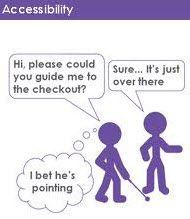1. What is accessibility testing?
Accessibility Testing is defined as a type of Software Testing that is performed to ensure that the application being tested is usable by people with disabilities such as hearing, color blindness, old age and other disadvantaged groups.
It is a subset of Usability Test.

People with disabilities use assistive technologies that help them operate software products. An example of this software is:
Speech recognition software: It will convert spoken words into text, used as input to the computer.
Screen reader software: Used to read text displayed on the screen
Screen enlargement software: Used to enlarge the screen and make it easy for visually impaired users to read.
The keyboard is specially designed for users who are easy to type in, who have difficulty controlling a motor.
2. Reasons to test accessibility
Reason 1: Access to the market for people with disabilities:
About 20% of the population are people with disabilities.
- 1 out of 10 people with severe disabilities.
- 1 in 2 people over 65 years of age have a functional impairment.
The definition of a disability includes blindness, deafness, a disability or any other bodily disorder. A software product can cater to this large market if it makes it accessible to people with disabilities. Accessibility problems in software can be solved if Accessibility testing becomes part of general general testing life cycle.
Reason 2: Compliance with the laws on accessibility
Government agencies around the world have put in place legislation that requires IT products to be accessible to people with disabilities.
Below are government regulations on accessibility laws:
- United States: The Americans Act and Outreach Acts – 1990
- UK: Disability Behavioral Discrimination Act – 1995
- Australia: Disability Behavioral Discrimination Act – 1992
- Ireland: Disability Law 2005 Thus, accessibility testing is very important to ensure compliance with the law.
Reason 3: Avoid unwanted lawsuits:
In the past, Fortune 500 companies have been sued because their products are not disabled friendly. Here are a few prominent cases:
- National Federation of the Blind (NFB) vs Amazon (2007)
- Sexton and NFB vs Target (2007)
- Settlement between NFB Vs AOL (1999) The best thing is to create products that support people with disabilities and avoid unwanted lawsuits.
3. What disabilities are supported
The app must support people with disabilities like –
| Type of disability | Disability description |
|---|---|
| Vision impairment | Total blindness or color blindness or poor vision – Visual problems such as image flickering and flicker effect problems |
| Physical disability | Unable to use a mouse or keyboard with one hand.- Poor motor skills such as sluggish hand and muscle movements |
| Cognitive disability | Difficulty in learning or Poor memory or unable to understand more complex situations |
| Literacy disability | Read the problem |
| Hearing impairment | Hearing problems such as deafness and hearing loss – Inability to hear or to hear clearly |
4. Checklist accessibility check
The following points should be carefully checked for the application used by all users:
- For each mouse, joystick, or window operation, a visible virtual keyboard is required.
- Instructions for use must be provided with software or application in plain and easy-to-understand language supported with images where needed.
- Users can move between controls and objects using the tab button. Movement should be sequential or logical with a seamless flow.
- The user should be able to navigate within the app using standard shortcuts, especially for menu items.
- Application must support all or most commonly used operating systems.
- Selection of images and images in the application must be appropriate and easy to understand for the user.
- If there are audio and video options, then the user can control them as well.
- User can change default fonts and sounds according to their needs and requirements.
- The app’s color scheme is consistent and easy to read for all users.
- Make sure the audio and video content is clear and easy to understand for people with disabilities.
Although this list is not exhausted, it is still the starting point for your application accessibility testing process. More points may be added specifically to the application under test (AUT).
